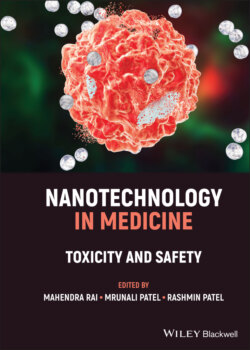Читать книгу Nanotechnology in Medicine - Группа авторов - Страница 22
На сайте Литреса книга снята с продажи.
1.6 Safety Issues and Regulations
ОглавлениеA number of nanomedicines have been approved for cancer treatment by the FDA and the European Medicines Agency (EMA). The FDA, EMA, and other regulatory agencies have not yet explicitly adopted recommendations for drug products containing not so hard materials (Wu et al. 2020). In the absence of guidelines for the review of nanomedicine therapeutics, regulatory decisions can be taken only on the basis of an individual evaluation of benefits and risks. The regulatory process is therefore laborious and involves a sophisticated specialist in emerging technology, which could result in regulatory delays (Juillerat‐Jeanneret et al. 2015; Singh et al. 2019). Also, regulatory concerns are critical for the production of cutting‐edge technology to define and monitor, in addition to clinical trials and the approval process, the safety of nanomedicine products. There is an immediate need for comprehensive characterization and quality control protocols. It is important to build more sophisticated and multifunctional tools for assessing the safety of nanotherapeutics, even as the difficulty of the approval process may be increased. To date, understanding has not been reached about how to determine the safety of nanomaterials using efficient approaches and standards that are approved by regulatory bodies. There are several explanations for this: lack of established reference material for benchmarking the effects of the material being tested, lack of clarity on predictive endpoints for human toxicity, technological shortcomings of nanomaterial testing, and batch‐to‐batch variations due to inadequate control over the development process. Many government and nongovernment groups have been attempting to find out how to handle this topic for the past two decades (Fadeel et al. 2007; Oberdorster 2010; Pelaz et al. 2017).
In clinical trials, nanomedicine drugs should have a desirable pharmacology and toxicity profile and show safety and efficacy. In order to further link the physicochemical assets of nanomedical systems with biological consequences, successful incorporation of capital from academia, business, government organizations, and hospitals would be critical. To leverage each partner's specific strengths, it is important to cultivate collaborations between major pharmaceuticals, smaller firms, and academia early in preclinical growth (Havel et al. 2016). The definitions, quality requirements, recommendations and regulatory concerns of nanomedicine should be defined and reciprocated by health authorities (Zhao and Castranova 2011; George et al. 2015). Although any new drug conceptually needs to meet comparable challenges, the basic sophistication and multicomponent existence of nanomedicines contributes to a vast range of additional variables that may raise further concerns considerably. Nanomedicine will go on to the next step and bring practical and meaningful benefit to human medicine and healthcare by rationally planned and systematic approaches to overcome various safety issues and solve the problems.
